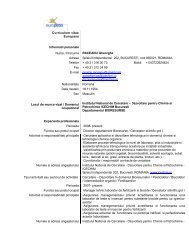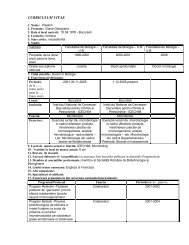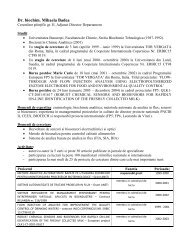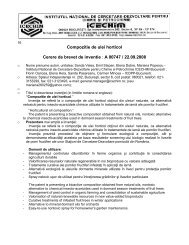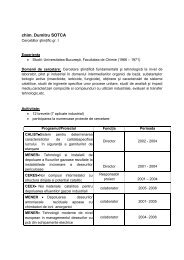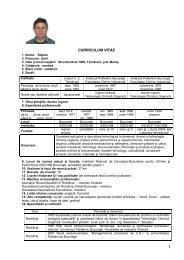INSTITUTUL NAÅ¢IONAL DE CERCETARE-DEZVOLTARE - ICECHIM
INSTITUTUL NAÅ¢IONAL DE CERCETARE-DEZVOLTARE - ICECHIM
INSTITUTUL NAÅ¢IONAL DE CERCETARE-DEZVOLTARE - ICECHIM
- No tags were found...
Create successful ePaper yourself
Turn your PDF publications into a flip-book with our unique Google optimized e-Paper software.
BIOSENSORS BASED ON SCREEN-PRINTED ELECTRO<strong>DE</strong>S1 Bioresources and biomaterials - PFlorentina Hutanu, Gheorghe Gutt’ Stefan cel Mare’ University of Suceava - Universitatii 13, 720229 Suceava, Romania, tel. 0230 216147, fax0230 520267. e-mail: florentinah@fia.usv.ro; g.gutt@fia.usv.roScreen printing seems to be one of the most promising technologies which allow biosensors to become largelycommercialized on the market. Enzymes may be immobilized by a variety of the classical methods. Thesemethods are however complex and meticulous and thus their transfer to an industrial scale production is difficultand expensive. A solution to this problem represents the most innovative technique in the field of biosensors isrepresented by the deposition of the enzyme by printing it in the same time with the fabrication of the SPE [1].Unfortunately, electrochemical sensors produced with this method not always have identical analyticalparameters. In the case of amperometric sensors the main sources of irreproducibility, with unfavorableconsequences for amperometric sensors, are: heterogeneity of the ink used for printing of the chemicallysensitive element of electrode resulting though an irreproducible surface of the printed electrode and also theinstability in time of the electric contacts and the reference electrode. In addition to the unquestionableadvantages, there exist also a number of practical problems in the use of enzymes. To these belong: the high costof isolation and purification of enzymes, the instability of their structures once they are isolated from theirnatural environments, and their sensitivity both to process conditions other than the optimal ones, normallynarrow-ranged, and to trace levels of substances that can act as inhibitors. However, the significativeimprovements of these kind of biosensors are mainly expected from two different ways: new printable materialsand new support surfaces. With this aim, new attempts for the modification of the working electrode are also incontinuous growth, focusing on new ligands, polymers and nanostructured materials [2]. A comparative studyregarding the design of the SPE based biosensors will be presented.[1] Barbara Krajewska , Enzyme and Microbial Technology 35 (2004) 126 -139[2] O. Domınguez Renedo, M.A. Alonso-Lomillo, M.J. Arcos Martınez Talanta 73 (2007) 202 - 219




